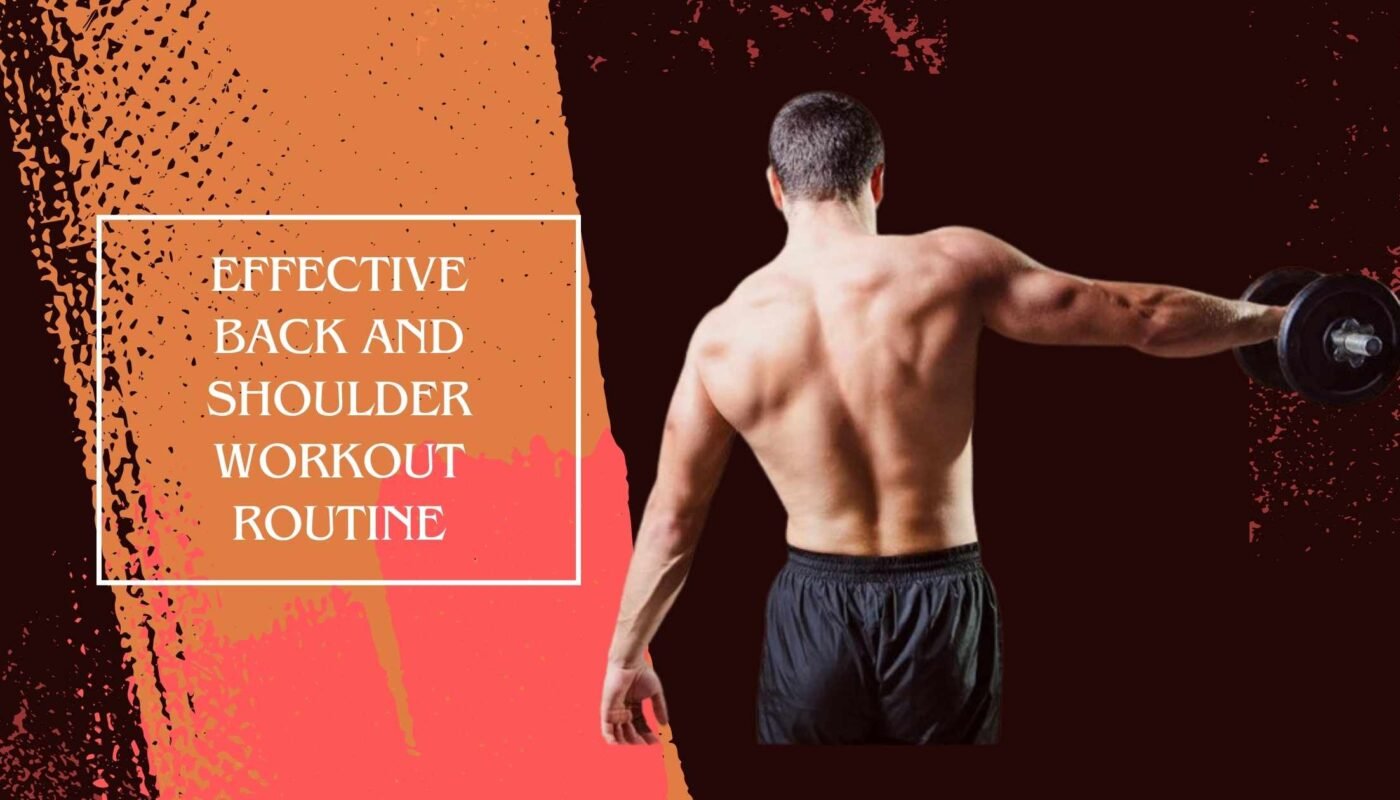Imagine walking into the gym, feeling excited and a bit nervous. You look at the weight section, where people are working on their upper bodies. You see someone doing a great back and shoulder workout, moving smoothly from pull-ups to barbell rows. Their strong back and defined shoulders look amazing and help them in sports and everyday tasks.
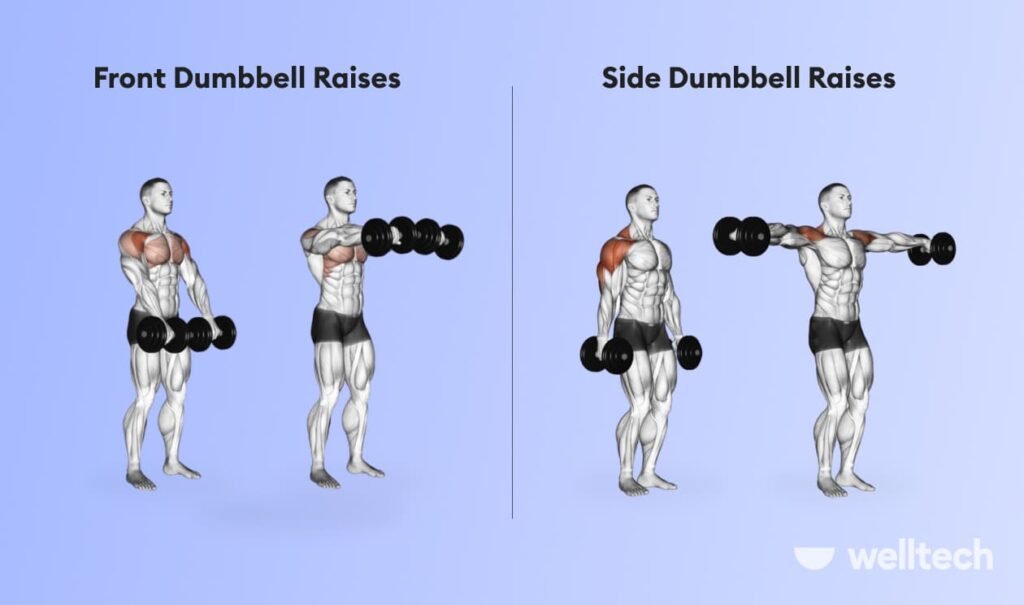
Strength training is more than just looking good. Studies show that the right back and shoulder exercises can help with back pain and make life better. A good workout plan for these muscles helps you build strength and avoid injuries from bad form or overdoing it. It’s important for both new and experienced gym-goers to know about these muscles.
Let’s check out the best ways to work your back and shoulders. We’ll focus on getting the most out of your workouts, avoiding pain, and keeping them fun. This guide is for anyone wanting to beat pain, improve their abilities, or just look good. Let’s get into effective upper back and shoulder exercises!
Table of Contents
Introduction to Back and Shoulder Training

Adding back and shoulder exercises to your workout is key for strength and better physical performance. These muscles help with everyday tasks, improve movement, and lower injury risks. A good workout plan for shoulders and back also helps with posture and supports the spine.
Many people don’t realize how important it is to work on the back and shoulders. Strengthening these areas helps with a balanced body and better movement. Activities like lifting and reaching get easier with a strong back. Exercises like rows and overhead presses build functional strength, important for athletes and those who love fitness.
Some people think focusing on one muscle group, like the back, will make it grow too much. Others worry that strength training will make them too bulky. But, a balanced approach with slow increases in intensity and proper form is key. Working with expert trainers and using good equipment also helps get the best results safely.
- Use lighter weights to build shoulders without getting too big.
- Work on all three parts of the deltoids for a full shoulder workout.
- Do exercises that help activate and stretch the shoulders to lower injury risks.
Adding a back and shoulder day to your workout routine boosts your overall fitness. Setting achievable goals keeps you motivated. Celebrating your progress helps you stay committed to your fitness goals.
| Benefit | Description |
|---|---|
| Improved Posture | Strengthening the back helps keep you standing up straight and avoids slouching. |
| Enhanced Daily Activities | A strong back and shoulders make everyday tasks like lifting and reaching easier. |
| Functional Movement | Doing compound exercises improves coordination and boosts your physical performance. |
| Injury Prevention | Training specific muscles helps prevent injuries by reducing muscle imbalances. |
Benefits of Combining Back and Shoulder Workouts
Working out your back and shoulders together has many benefits. It helps improve your physical performance and looks. It also makes your upper body training more complete.
Improved Muscle Balance
Exercising both your back and shoulders helps with muscle balance. This balance reduces the chance of getting hurt or having posture problems. It builds a strong base for staying aligned and coordinated in daily activities.
Enhanced Performance and Strength
Having a strong back and shoulders makes you more stable. This means you’ll do better in sports and everyday tasks. You’ll be stronger and more efficient in lifting, pushing, and pulling things.
Aesthetic Improvements
Working on your back and shoulders also makes you look better. A strong back and broad shoulders look great together. You’ll feel more confident showing off your new look.
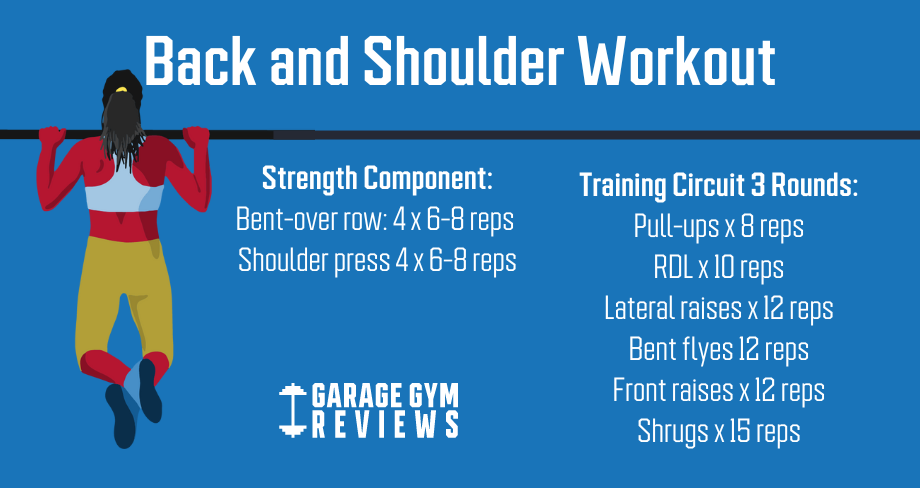
| Benefit | Description |
|---|---|
| Improved Muscle Balance | Prevents injuries and postural issues through balanced development. |
| Enhanced Performance | Increases upper body stability and strength for improved physical activities. |
| Aesthetic Improvements | Contributes to a broader shoulder appearance and strong back for a pleasing physique. |
Understanding Back and Shoulder Anatomy
Knowing how the back and shoulders work is key to making good workout plans. It helps in getting stronger and avoiding injuries. Each muscle has its own job in exercises, affecting how we move and perform.
Let’s look at the main muscles in the back and shoulders.
Key Muscle Groups in the Back
The back has many muscles that work together for different movements, like lifting. Important back muscles are:
- Latissimus Dorsi: This big muscle goes from the lower back to the upper arm. It helps with arm movements and pulling.
- Rhomboids: These muscles are between the shoulder blades. They pull the scapula back and help keep good posture.
- Trapezius: This muscle covers the upper back and neck. It helps lift and stabilize the shoulders.
- Erector Spinae: Along the spine, this group supports the back. It lets us extend and rotate the back.
Key Muscle Groups in the Shoulders
Shoulders have the deltoid muscle and rotator cuff, which are crucial for stability and movement. The deltoids have three parts:
- Anterio r Deltoid: This head is mainly for moving the arm forward.
- Lateral Deltoid: It helps move the arm out to the side, making the upper body wider.
- Posterior Deltoid: This part helps extend and stabilize the shoulder, controlling arm movements backward.
The rotator cuff, with muscles like infraspinatus and supraspinatus, is key for keeping the shoulder stable. Doing exercises like the Dumbbell Shoulder Press works all three deltoid heads. This helps develop the shoulders fully.
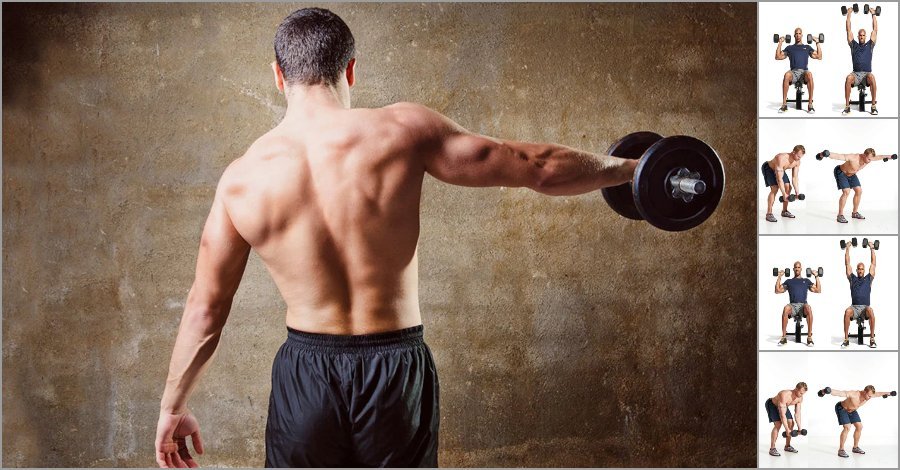
Essential Equipment for Your Workout
Choosing the right equipment is key to reaching your fitness goals, especially for back and shoulder workouts with dumbbells. The right tools make workouts more efficient, safe, and comfortable. Here are some must-have pieces of equipment for your back shoulder workout with dumbbells.
Dumbbells and Barbells
Dumbbells are great for working out your shoulders and back with weights. They let you do many exercises that target different muscles. With dumbbells, you can do both isolation and compound exercises, making your workouts more effective. Barbells are good for lifting heavier weights and are great for exercises like rows and presses to build overall strength.
Weight Bench and Cable Pulley Machine
A strong weight bench is key for doing many exercises safely and with good form. It helps with lifting weights overhead and keeping your back stable during exercises. The cable pulley machine offers different resistance types that target specific muscles. It’s perfect for adding variety to your shoulder and back workouts.
Effective Back and Shoulder Workout Structure
Creating a structured workout plan is key to getting fit for back and shoulders. It includes various exercises in a sequence to work muscles well and avoid hitting a plateau.
Start with a 5-10 minute warm-up of light cardio and dynamic upper body stretches. This gets muscles and joints ready for the workout. Then, move on to back and shoulder exercises, mixing compound and isolation moves. Here’s a sample plan:
| Exercise | Sets | Reps | Rest Time |
|---|---|---|---|
| Dumbbell Shoulder Press | 3 | 8-10 | 45 sec |
| Pull-Ups | 3 | 8-10 | 45 sec |
| Push-Ups | 3-5 | 10-15 | 45 sec |
| Front and Side Dumbbell Raises | 3 | 10-12+ | 45 sec |
| Barbell Deadlifts | 3-5 | 6 | 45 sec |
| Dumbbell Reverse Flyes | 3 | 10-12 | 45 sec |
| Dumbbell Rows | 3-5 | 8 (per side) | 45 sec |
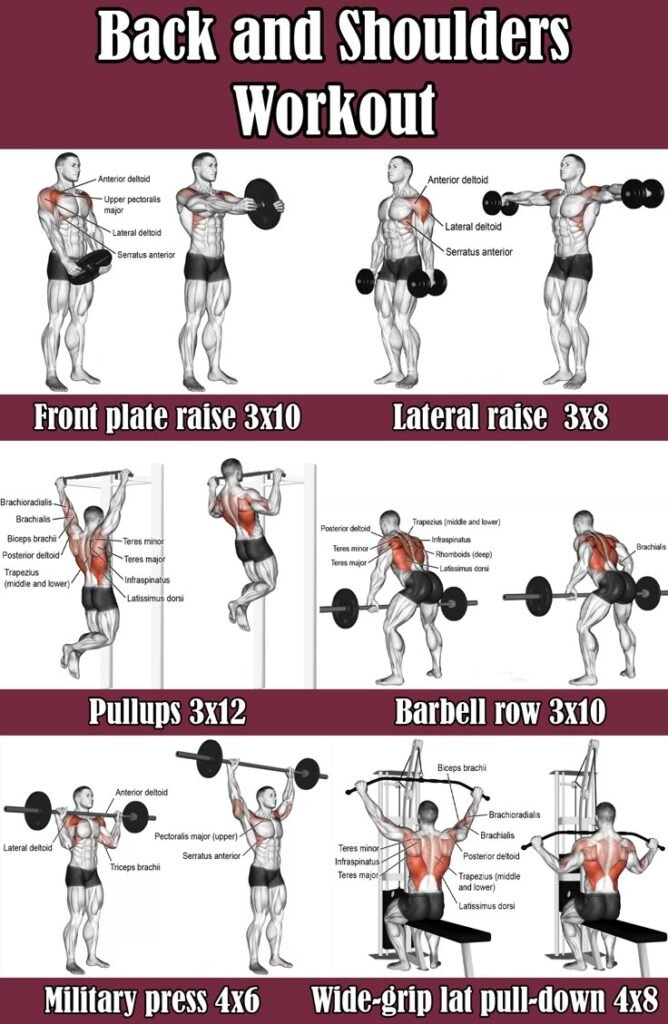
Adding superset training boosts your workout by saving time and increasing intensity. Doing exercises back-to-back raises your heart rate and helps muscles grow by working them from different angles.
End your routine with 5-10 minutes of stretching to improve flexibility and aid recovery. Stick to the structured plan, focusing on rest and good nutrition, to help muscles grow and improve performance.
Warm-Up for Back and Shoulder Exercises
Warming up is key before starting any exercise, especially for back and shoulder workouts. It boosts blood flow to muscles, making you perform better and reducing injury risks. A good warm-up prepares muscles and joints for a tough workout.
Importance of Warming Up
Starting with a back workout warm-up has many benefits. It activates the core and spine, vital for upper-body exercises like the overhead press and row. Using bodyweight movements and resistance bands is safer and more effective than heavy weights.
It’s smart to do an upper-body warm-up with five moves for back, chest, and shoulders. Repeat these moves 2-3 times to get ready for your workout.
Dynamic Stretching for Shoulders
Dynamic stretching is crucial for shoulder prep. Exercises like YTW, Band Pull-Apart, and Face Pull boost motion and muscle activation. YTW exercises get joints ready and improve muscle stability. Band Pull-Apart targets rear delts for better lifting mechanics.
Doing these dynamic stretches for under 30 seconds each gets your body ready for the workout. Adding active lat stretches and rotator cuff exercises is also key for a great warm-up.
- [2 Exercise modes & Detachable Handles] By changing the connection ways between the hoist buckle and the high strength a…
- [Professional Components] Breakingproof ball design of the cable and heavy-duty alloy buckle can prevent the rope from b…
- [Premium Material] Includes with 70-inches and 90-inches high-strength sheathed cables, provides more cable length optio…

- Comprehensive Upper Body Training: This chest machine combines a chest press and butterfly arm features, allowing for a …
- Customizable Comfort: Features a 4-level adjustable seat, ensuring users of various heights can exercise comfortably and…
- Gradual Resistance Adjustment: This pec deck fly machine supports adjustable resistance with compatibility for 1″ openin…
- 💪【UPGRADE LATEST DESGIN】: SPART Multifunctional Strength Station adopts the latest revolutionary full-body training desi…
- 💪【FULL BODY WORKOUTS】: This leverage workout equipment is constructed with 13 gague, 2.5mm thick tube, which ensures saf…
- 💪【LEVERAGE GYM WORKOUT BENCH】: The leverage gym can be used together with the bench but also can used alone by turning t…
- [Precise and Strong Stimulation]-Our seated row machine is designed to more effectively target your back muscles and pro…
- [Dual Grip Handles]-This seated row machine plate loaded comes with two different types of grips. The fully rotating gri…
- [Independent Arms & Adjustability]-The lat machine’s diverging arms can be utilized together or independently, offering …
- Full Body Workout Station: Our home gym station is an all in one strength training machine for full body workouts. You c…
- All the Components Include: This home gym system comes with full body training attachments, which includes 1x lat pull d…
- Plate Loaded Home Gym: This home gym station adopts plate loaded design, which means you can load more weights than the …
- [Precise and Strong Stimulation]-Our seated row machine is designed to more effectively target your back muscles and pro…
- [Dual Grip Handles]-This seated row machine plate loaded comes with two different types of grips. The fully rotating gri…
- [Independent Arms & Adjustability]-The lat machine’s diverging arms can be utilized together or independently, offering …
Best Back and Shoulder Exercises
Adding the best back and shoulder exercises to your workout can boost your upper body strength and look. Exercises like pull-ups work on muscle density in the back. Shoulder exercises help with stability and strength. Here are key exercises that target these areas well.
Pull-Up and Lat Pulldown
Pull-ups are a top choice for working the back muscles, especially the latissimus dorsi. They also widen the upper back. If pull-ups are tough, lat pulldowns are a good substitute. Both exercises can be done with different grips to work various muscles, making them great for strength training.
Barbell Row and Dumbbell Row
Barbell and dumbbell rows are great for adding thickness to the back. They work on muscles like the rhomboids, trapezius, and rear deltoids. Doing these exercises right helps activate muscles fully and lowers injury risk. For strength, do 4-5 sets of 5-8 reps.
Overhead Press Variations
Overhead press exercises, like the standing barbell press and seated dumbbell press, focus on shoulder strength. They work the deltoid muscles and also engage the triceps and upper chest. For muscle growth, aim for 3-4 sets of 8-12 reps. Adding these exercises to your routine will improve shoulder stability and functional strength.
| Exercise | Optimal Sets | Optimal Reps | Main Muscles Targeted |
|---|---|---|---|
| Pull-Up | 4-5 | 4-6 (Strength) | Latissimus Dorsi, Biceps |
| Lat Pulldown | 3-4 | 6-10 (Hypertrophy) | Latissimus Dorsi, Teres Major |
| Barbell Row | 4-5 | 5-8 (Strength) | Rhomboids, Trapezius |
| Dumbbell Row | 3-4 | 8-12 (Hypertrophy) | Rhomboids, Posterior Deltoid |
| Overhead Press | 4-5 | 5-8 (Strength) | Deltoids, Triceps |
| Seated Dumbbell Shoulder Press | 3-4 | 8-12 (Hypertrophy) | Deltoids, Triceps |
Adding these exercises to your weekly routine will make your upper body stronger and more defined. Mix up the exercises to keep your workouts interesting and effective.
Sample Back and Shoulder Workout Routine
This back and shoulder workout routine is designed to help you build muscle. It’s flexible, with exercises that focus on strength and endurance. This training session example covers everything you need for a full workout.
The routine starts with a 30 Rep Challenge. Then, it moves to two Giant Sets with four exercises each. This ensures you work out every muscle group thoroughly.
| Training Phase | Sets | Reps | Rest Interval |
|---|---|---|---|
| 30 Rep Challenge | 1 | 30 | 1 minute |
| Giant Set 1 | 3 | 8-12 | 30 seconds |
| Giant Set 2 | 3 | 8-12 | 30 seconds |
| 3-Minute Ladder Burnout | 1 | Max Reps | N/A |
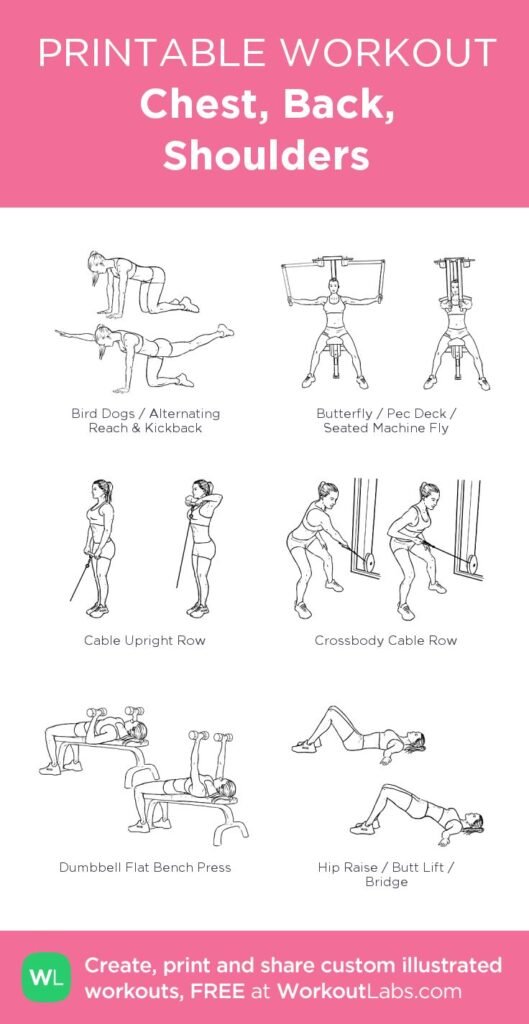
This routine works on the lower and upper back, lats, rhomboids, and shoulders. Use dumbbells that feel right for you, usually 10 to 25 lbs. Adjust the weights to challenge yourself but stay safe.
Include exercises like the standing overhead barbell shoulder press and seated dumbbell shoulder press. Also, do standing dumbbell lateral raises. Always focus on proper form to avoid injuries and work your muscles effectively.
Always warm up before your workout and take time to recover after. This routine is a great way to boost your strength and look better.
Tips for Maximizing Your Workout
To make the most of your fitness journey, focus on key elements. Strength training with the right form and nutrition helps grow muscles and boost performance. Here are tips and best practices to improve your training.
Proper Form and Technique
Using the right form in exercises is crucial for strength training. Wrong techniques can cause injuries and slow down progress. For instance, doing shoulder presses and push-ups correctly is important to work the right muscles. Here are ways to better your workout:
- Pay attention to your posture and alignment.
- Perform movements slowly to ensure muscle engagement and control.
- Incorporate warm-up exercises focusing on shoulder mobility to enhance flexibility and reduce injury risks.
Nutrition and Recovery Strategies
What you eat is key to recovering and growing muscles. Eating enough protein, about 1 gram per pound of body weight, helps repair and grow muscles after working out. Here are important practices to follow:
- Calculate your daily caloric intake, with an increase of around 500 calories per day to promote muscle gain.
- Emphasize balanced meals with protein, carbohydrates, and healthy fats.
- Hydrate adequately and ensure sufficient rest between workouts to facilitate recovery.
| Nutrition Strategy | Focus Area | Expected Outcome |
|---|---|---|
| Increased Protein Intake | Supports muscle recovery | Enhanced muscle growth |
| Caloric Surplus | Promotes muscle gain | Steady weight increase |
| Hydration | Maintains energy levels | Improved workout performance |
| Sufficient Rest | Facilitates recovery | Reduces injury risk |
Adding these tips to your routine can greatly improve your strength training. Remember, progress takes time. Stay consistent with these strategies for better muscle growth and fitness.

Common Mistakes to Avoid
Training the back and shoulders can be rewarding but also challenging. It’s key to avoid common workout mistakes to get the best results and avoid injuries. Many people make mistakes that can slow down their progress and cause injuries. Knowing these mistakes helps you train better and stay healthy.
Overtraining and Insufficient Rest
Overtraining without enough rest is a big issue in back and shoulder training. Doing too many workouts can lead to muscle tears and rotator cuff injuries. It’s important to include rest days in your routine. Many people don’t realize how crucial rest is to avoid burnout and injury.
Ignoring the balance between training and rest can lead to problems. Overworking the front deltoids can cause muscle imbalances. Not training the rear deltoids enough can lead to neck and back pain.
Poor Exercise Selection and Form
Choosing the wrong exercises or ignoring proper form can really slow down your progress and increase injury risks. For example, ego lifting can cause muscle tears and strains. Using too much momentum during exercises like side laterals and front raises makes things worse.
It’s important to keep your hands level with your chin during overhead presses. Using a mix of exercises is also key for good shoulder development. Free weights alone might not be enough. Knowing these tips can make your workouts more effective and safer.
Tracking Your Progress
It’s key to keep an eye on your workout progress to hit your fitness goals. Regularly tracking your workouts gives you deep insights into how you’re doing. A training log not only keeps you on track but also shows how much you’ve improved. This info is vital for tweaking your workout plans to keep getting better.
Using a Training Log
Keeping a training log is super helpful. It’s a great way to note down sets, reps, and what you think after your workout. By tracking these things, you can spot patterns and see where you need to get better. For instance, logging how long you’re active each week helps make sure you hit the 150 minutes goal.
Seeing changes in your clothes or body size shows real progress, not just the number on the scale. Apps like MyFitnessPal and Jefit make logging your workouts easy and fun.
Adjusting Workouts Over Time
Changing your workout plans based on what you log leads to stronger muscles and better performance. Weights can change from day to day, so checking them weekly is smart. Tools like body composition checks give you a clear picture of your fitness level.
Doing exercises like push-ups or burpees shows how far you’ve come. Taking pictures and measuring your body helps track changes well. Focusing on different areas of fitness, not just weight, keeps your workouts interesting and fulfilling.
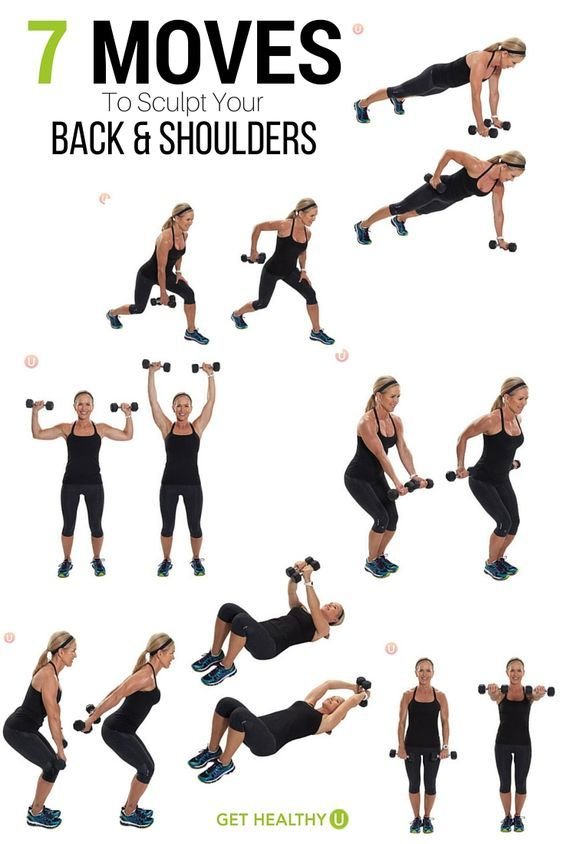
How Often to Train Your Back and Shoulders
It’s key to find the right training frequency for back and shoulders for muscle growth and recovery. Experts usually say to train these muscles 2 to 3 times a week. This helps grow muscles without overdoing it.
A good workout schedule for back and shoulders might include 3-4 sets per exercise. This makes sure you’re doing enough to grow muscles but not too much. For example, Dr. Mike Israetel suggests 8-12 sets a week for certain back and shoulder muscles. This helps muscles grow evenly.
Here’s a sample plan for training frequency:
| Week | Training Days | Exercises | Total Sets |
|---|---|---|---|
| 1 | Mon, Wed, Fri | Push Press, Lateral Raises, Pull-Ups | 12 |
| 2 | Tue, Thu | Dumbbell Shoulder Press, Bent-Over Row | 10 |
| 3 | Mon, Fri | TRX Reverse Flye, Upright Row | 8 |
It’s important to watch how often you train to see good results. You might need to change things based on how you recover and your training level. Training regularly helps muscles grow and lowers injury risk. So, think about your goals and what you like when planning your workout schedule.
Conclusion: Setting Goals For Your Workout
Starting your fitness journey needs careful planning. Setting clear goals is key. Make sure they are specific, measurable, achievable, relevant, and time-bound (SMART). This plan helps you stay on track and motivated.
Adding structured goals to your routine makes a big difference. Studies show that focused training leads to better results. For example, focusing on the mind-muscle connection boosts muscle growth. Knowing what you want to achieve keeps your training focused and keeps you motivated.
It’s important to check and adjust your goals as you move forward. This keeps you on track and makes sure your workouts match your abilities. Setting clear goals and embracing growth makes your workouts rewarding. It turns exercise into a way of life.

